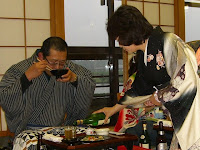THE TWISTARS matches Okinawa food. Maybe, this is because Mr. Akira Kawabata, one of their members, is from Yoron Island (this island is close to Okinawa and shares culture and folkways with it) and pursues solo stuff in Okinawa prefecture. Actually, their music has a kind of Okinawa taste.
I enjoyed music drinking beer, kusu, and hahadagi paired with jiimamii tofu, mimigaa, tofuyo, rafti, and other Okinawa foods. My favorite drinks were local Ishigakijima beer and 8-year aged Dachibin-original kusu.

They had also Okinawa sake in this restaurant. The sake is called Reimei, brewed by Taikoku Shuzo.

The sake Reimei at this time seemed to be honjozo sake. It was dry and bold sake and reminded me of sake from Nada, Hyogo prefecture. I think hot areas like Okinawa do not yield much sake, and it was a surprise that they are producing such good sake in Okinawa prefecture.
Today's Sake
Ginjo Nakagumi 2008BY Namazake (Ozawa Syuzou)
The sake has a modest aroma (I usually favor modest aroma than too much fruity ginjoka). When I take a sip of this sake, my tongue feels stimulation characteristic of namazake, but soon it finds a mild taste. Leave this sake for a while after taking it out from the refrigerator. This sake will soon reveal its elegance and gracefulness.
Rice used: Gohyakumangoku and Miyamanishiki
Seimaibuai: 55%
Alcohol: 17.0 - 18.0%
Sake meter value: (+)3
Acidity: 1.7
Amino acid: 1.1














